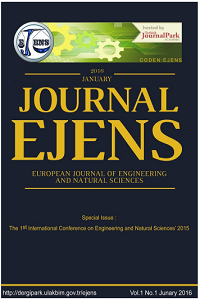Investigation and Evaluation of Degradability of Ibuprofen from Wastewater by Using Fenton Process
Investigation and Evaluation of Degradability of Ibuprofen from Wastewater by Using Fenton Process
Ibuprofen, Fenton Process, Pharmaceuticals Water,
___
- [11]. V. Kavitha, K., Palanivelu, “The Role of Ferrous Ion in Fenton and Photo-Fenton Processes for the Degradation of Phenol,” Chemosphere, vol 55, pp 1235-1243, December, 2003.
- [12]. C. Wailling, “Fenton’s Reagent Revisted, “Accounts of Chemical Research, vol8, pp 125-131, April, 1975.
- [13]. T. Scheytt, P. Mersmam R., Lindstadt and T., Heberer,” 1-Octanol / Water Partition Coefficients of 5 Pharmaceuticals from Human Medical Care: Carbamazepine, Clofibric Acid, Diclofenac, Ibuprofen and Propyhenazone,” Water, Air and Soil Pollution, vol 165, pp 3-11, March, 2005.
- [14]. (2017) ChemSpider Search and Share Chemistry [Online]. http://www.chemspider.com/Chemical-Structure.3544.html#
- [15]. G. Sonmez, “Removal of some pharmaceutical residues by advanced chemical oxidation process”, Aksaray University, Science Enstitue, November, 2015.
- [16]. S. Ustun Odabasi, B. Maryam, H. Buyukgungor, “Assessment and Investigation of Paracetamol from Wastewater By Using Oxidation Process and TOC,” 3rd International Conference on Recycling and Reuse, 2015, pp161-166 .
- [17]. Y.W. Kang, ve K.. Hwang, “Effect of reaction conditions on the oxidation efficiency in the Fenton process”, Water Research,vol 10, pp 2786-2790, Jully,2000.
- Başlangıç: 2015
- Yayıncı: CNR Çevre
PSIM Simulation of Flyback Converter for P&O and IC MPPT Algorithms
Process Design for the Recycling Of Tetra Pak Components
Diagnosis of Coronary Artery Disease Using Deep Belief Networks
Nonlinear Buckling Analysis of Cold-Formed Channel Sections
Effect of High Dosage Air-Entraining Admixture Usage on Micro Concrete Properties
Comparison of Performance of Conventional Membrane Bioreactor with Dynamic Membrane Bioreactor
